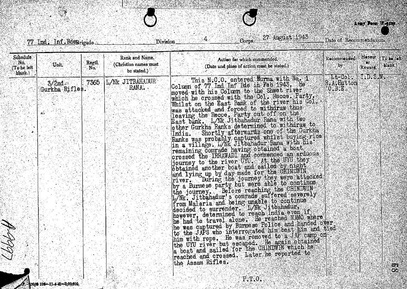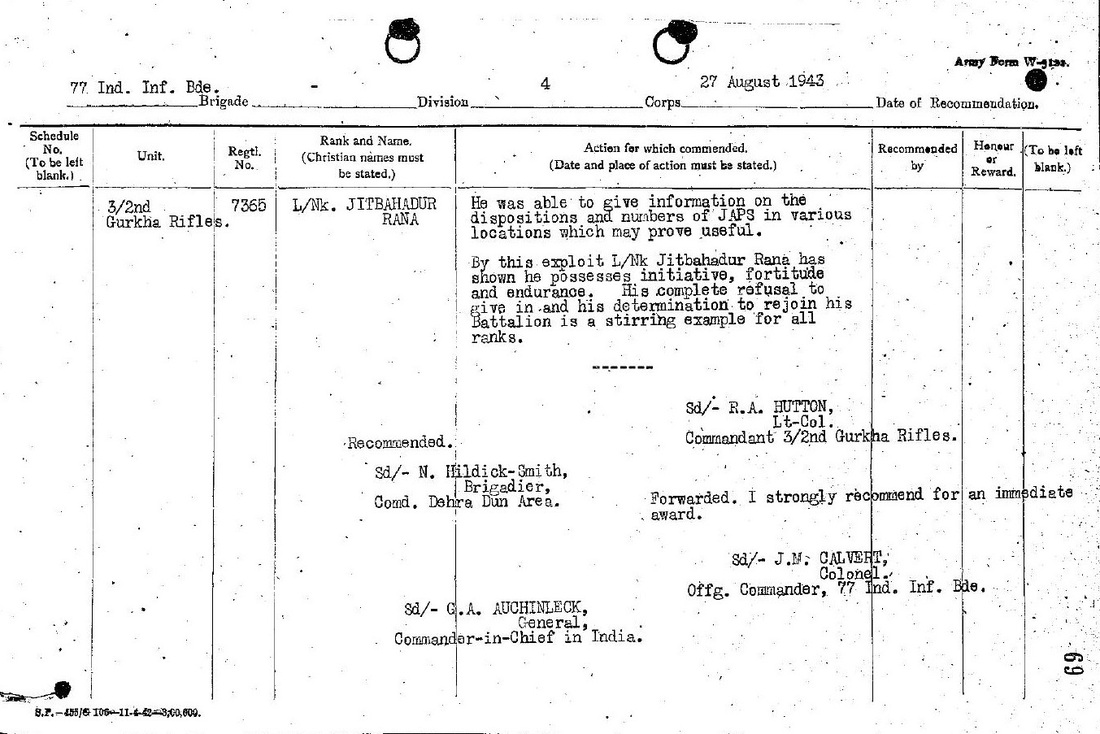Jemadar Man Bahadur Gurung I.O.M.
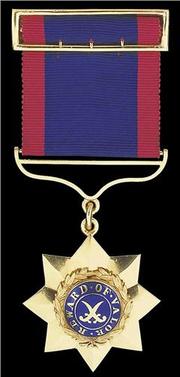
The untried junior officer walked slowly along the rail tracks, looking occasionally at the night sky above he wondered what adventures lay ahead for him during his time behind enemy lines in Burma. He did not have to wait long as within seconds the quiet Burmese evening was turned into a chaotic inferno, as a Japanese ambush engulfed the unsuspecting Chindits of column 2.
Acting on instinct Man Bahadur dropped down into the gravel embankment and drew his rifle forward in front of him, he called out to his platoon to do the same. Unbeknown to the Chindit column, over 800 Japanese troops had made their way up to Kyaikthin village during the day and had lay in wait for them for the last few hours. Now the Japanese attacked the Gurkhas with everything they possessed and succeeded in cutting the column down into small and disjointed units of men.
A British officer called for dispersal and the signal was given, for those who could hear and understand the instruction it had not come a moment too soon and they melted away into the nearby scrubland and headed east. Column commander Major Emmett had pre-arranged a rendezvous a few miles further east, this was set out specifically for such events as an ambush, but the Japanese had surprised the young Gurkha unit and confusion got the better of them that night.
Jemadar Man Bahadur Gurung and some of his platoon had managed to hold their small position and this had allowed many of the muleteers and other personnel to withdraw into the jungle. He now called to his men to do the same. Once they had moved a sensible distance away from the chaos of the embankment Man Bahadur took time to assess the condition of his platoon. He found that they had faired reasonably well considering the circumstances of the engagement. The platoon was still in good fighting order, although it had lost two of it's best Riflemen in the form of Man Bir Bura and Man Bahadur Tamang. These losses saddened the young Jemadar as he reflected on his own performance that night.
Here is how the senior commander of column 2, Major A. Emmett recounted Man Bahadur's performance on the 2nd March 1943, shown in the form of his recommendation citation for the Indian Order of Merit (2nd Class), which was awarded to the young Jemadar that year:
For I.O. 1132 Jemadar Man Bahadur Gurung of the 3/2 Gurkha Rilfes, the award of the I.O.M. (2nd Class)
At KYAIKTHIN on the night of 2/3 March 1943, the column to which this officer belonged was ambushed. During the resulting confusion he displayed great coolness and courage. After the main body succeeded in breaking off the engagement and extricating itself, this officer continued to occupy the position which he had taken up and to keep the enemy engaged. Although outnumbered he continued to fight and concentrated upon himself the attention of the greater part of the enemy, thus distracting them from pursuing other dispersal groups.
Next day he continued to lead his platoon eastwards in the hope of finding other parties. After a prolonged and unsuccessful search he lead his party safely back to the CHINDWIN carrying several automatic weapons, additional to his own, which he had found abandoned.
London Gazette 16/12/1943.
Acting on instinct Man Bahadur dropped down into the gravel embankment and drew his rifle forward in front of him, he called out to his platoon to do the same. Unbeknown to the Chindit column, over 800 Japanese troops had made their way up to Kyaikthin village during the day and had lay in wait for them for the last few hours. Now the Japanese attacked the Gurkhas with everything they possessed and succeeded in cutting the column down into small and disjointed units of men.
A British officer called for dispersal and the signal was given, for those who could hear and understand the instruction it had not come a moment too soon and they melted away into the nearby scrubland and headed east. Column commander Major Emmett had pre-arranged a rendezvous a few miles further east, this was set out specifically for such events as an ambush, but the Japanese had surprised the young Gurkha unit and confusion got the better of them that night.
Jemadar Man Bahadur Gurung and some of his platoon had managed to hold their small position and this had allowed many of the muleteers and other personnel to withdraw into the jungle. He now called to his men to do the same. Once they had moved a sensible distance away from the chaos of the embankment Man Bahadur took time to assess the condition of his platoon. He found that they had faired reasonably well considering the circumstances of the engagement. The platoon was still in good fighting order, although it had lost two of it's best Riflemen in the form of Man Bir Bura and Man Bahadur Tamang. These losses saddened the young Jemadar as he reflected on his own performance that night.
Here is how the senior commander of column 2, Major A. Emmett recounted Man Bahadur's performance on the 2nd March 1943, shown in the form of his recommendation citation for the Indian Order of Merit (2nd Class), which was awarded to the young Jemadar that year:
For I.O. 1132 Jemadar Man Bahadur Gurung of the 3/2 Gurkha Rilfes, the award of the I.O.M. (2nd Class)
At KYAIKTHIN on the night of 2/3 March 1943, the column to which this officer belonged was ambushed. During the resulting confusion he displayed great coolness and courage. After the main body succeeded in breaking off the engagement and extricating itself, this officer continued to occupy the position which he had taken up and to keep the enemy engaged. Although outnumbered he continued to fight and concentrated upon himself the attention of the greater part of the enemy, thus distracting them from pursuing other dispersal groups.
Next day he continued to lead his platoon eastwards in the hope of finding other parties. After a prolonged and unsuccessful search he lead his party safely back to the CHINDWIN carrying several automatic weapons, additional to his own, which he had found abandoned.
London Gazette 16/12/1943.
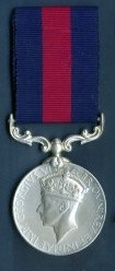
Subadar Kum Sing Gurung I.D.S.M.
On Operation Longcloth in 1943 the main objective of column 3 was to blow the railway tracks at a place called Nankan. Kum Sung Gurung was given a specific task by Major Calvert once the unit was in place and ready to demolish the railway, "guard the roadways and let nothing in or out while we are about our business".
Whilst the engineers were busy with their explosives two lorry load of Japanese soldiers arrived on the scene, here is how the Subadar dealt with the enemy intrusion, in the form of his Distinguished Service Medal citation as written by Calvert in 1943:
496 Subadar Kum Sung Gurung, 3/2 Gurkha Rilfes
Action for which recommended
On 6th March 1943, at NANKAN Railway Station, Subadar KUM SING was detached with one section and an anti tank rifle to guard a track while demolitions were being carried out on the railway. Two lorry loads of Japanese infantry arrived and drove straight into the ambush which he had laid. The majority were killed at the outset, but the remainder were reinforced. Subadar KUM SING continued to fight the enemy for two hours, gaining complete immunity from interruption for the parties engaged in demolishing the railway. He himself shot two of the enemy, on whom 15 casualties were inflicted without loss to our own troops. During the whole of the campaign as Senior Gurkha Officer with his column he maintained the morale and discipline of his men under trying circumstances and upheld the finest tradition of the Gurkha Officer.
Recommended By
Major J.M.Calvert, R.E.
Column Commander
77th Indian Infantry Brigade Group
London Gazette 05/08/1943.
As a short sub-note to this story; by chance a platoon from column 7 led by Captain W. Petersen (a Danish SOE officer) stumbled into the engagement at Nankan and helped defeat the Japanese intruders. He and his men enjoyed their chance to engage the enemy for the first time since their entry into Burma 3 weeks before. Between them Petersen and the capable Kum Sing easily dealt with the Japanese troops.
On Operation Longcloth in 1943 the main objective of column 3 was to blow the railway tracks at a place called Nankan. Kum Sung Gurung was given a specific task by Major Calvert once the unit was in place and ready to demolish the railway, "guard the roadways and let nothing in or out while we are about our business".
Whilst the engineers were busy with their explosives two lorry load of Japanese soldiers arrived on the scene, here is how the Subadar dealt with the enemy intrusion, in the form of his Distinguished Service Medal citation as written by Calvert in 1943:
496 Subadar Kum Sung Gurung, 3/2 Gurkha Rilfes
Action for which recommended
On 6th March 1943, at NANKAN Railway Station, Subadar KUM SING was detached with one section and an anti tank rifle to guard a track while demolitions were being carried out on the railway. Two lorry loads of Japanese infantry arrived and drove straight into the ambush which he had laid. The majority were killed at the outset, but the remainder were reinforced. Subadar KUM SING continued to fight the enemy for two hours, gaining complete immunity from interruption for the parties engaged in demolishing the railway. He himself shot two of the enemy, on whom 15 casualties were inflicted without loss to our own troops. During the whole of the campaign as Senior Gurkha Officer with his column he maintained the morale and discipline of his men under trying circumstances and upheld the finest tradition of the Gurkha Officer.
Recommended By
Major J.M.Calvert, R.E.
Column Commander
77th Indian Infantry Brigade Group
London Gazette 05/08/1943.
As a short sub-note to this story; by chance a platoon from column 7 led by Captain W. Petersen (a Danish SOE officer) stumbled into the engagement at Nankan and helped defeat the Japanese intruders. He and his men enjoyed their chance to engage the enemy for the first time since their entry into Burma 3 weeks before. Between them Petersen and the capable Kum Sing easily dealt with the Japanese troops.
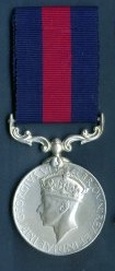
Lance Naik Jit Bahadur Rana I.D.S.M.
Jit Bahadur was awarded his gallantry medal for his almost super-human effort to return to Allied territory after general dispersal was called in late March 1943. A member of Column 1 under the command of Major George Dunlop, the young Lance Corporal went through weeks of near starvation and hardship as he inched his way back toward the Assam border. Of all the columns that set out in February that year, Dunlop's unit went the furthest east into Burma, they were also the last group to turn around and head home.
For Column 1 every obstacle on that return journey cost somebody's life or liberty. The river crossings especially tested the strength and resolve of the men, with only the determined of mind and spirit overcoming each hurdle. Men withdrew into their deepest and sometimes darkest thoughts, focusing only on the next step forward in their desperate attempt for survival.
Here is Jit Bahadur's citation in full and seen in it's original form, for some reason the recommendation was signed off by Mike Calvert the commander of Column 3, rather than Major Dunlop. Please click on the images to enlarge.
Jit Bahadur was awarded his gallantry medal for his almost super-human effort to return to Allied territory after general dispersal was called in late March 1943. A member of Column 1 under the command of Major George Dunlop, the young Lance Corporal went through weeks of near starvation and hardship as he inched his way back toward the Assam border. Of all the columns that set out in February that year, Dunlop's unit went the furthest east into Burma, they were also the last group to turn around and head home.
For Column 1 every obstacle on that return journey cost somebody's life or liberty. The river crossings especially tested the strength and resolve of the men, with only the determined of mind and spirit overcoming each hurdle. Men withdrew into their deepest and sometimes darkest thoughts, focusing only on the next step forward in their desperate attempt for survival.
Here is Jit Bahadur's citation in full and seen in it's original form, for some reason the recommendation was signed off by Mike Calvert the commander of Column 3, rather than Major Dunlop. Please click on the images to enlarge.
As a postscript to Jit Bahadur's Longcloth story, here is an article written about him in March 2007. From the pages of the Deccan Herald and researched by the journalist Sudeshna Sarkar:
Gurkha Hero gets rightful due from Britain
Now an Indian citizen, the 84-yr-old will receive 10,000 pound as compensation after languishing in Japanese prison camps in Burma during World War II.
For 18 long years, Jit Bahadur Rana staked his life for his employers. It brought him the ‘Indian Distinguished Service’ medal, but not much in the way of worldly comforts. And now, the 84-year-old World War II hero can look forward to buying a house.
Rana and the widow of another soldier will be the first Indians to receive a 10,000-pound compensation that the British government agreed to provide the former Gurkha soldiers under its employment in the 40s, who were captured in the Far East by the Japanese and kept in prison camps.
For these Gurkha war vets, the struggle did not end with the war. A bitter legal battle started in London in 2000 when three Nepalese Gurkhas, all of them in their 80s, sued the British defence ministry which decided to pay 10,000 pound each to the British Far East Prisoners of War (FEPOW), but overlooked the Gurkhas who had shared the same perils. In November 2002, the court ruled that Gurkhas too were eligible for the compensation and subsequently, the British government opened a FEPOW office in Kathmandu to assess claims for compensation.
Though hundreds of Indians too had fought in the British Army in those days of pre-Independence, they are not entitled to the compensation since in the 1950s, India signed a peace pact with Japan, settling the issue of compensation. Nepal is the only country that did not sign the treaty though its citizens fought in the allied army.
Jit Bahadur Rana is among the lucky vets who had Nepalese citizenship at the time of joining the British Army. Rana, after being discharged from the army in 1956, moved from Tanahu district in west Nepal to Dehra Dun and acquired Indian citizenship.
He was chosen for an extremely dangerous guerrilla mission that became known as the Chindit expedition, when he was 22. The mission sought to airdrop troops in the jungles of Burma, now Myanmar, occupied by the Japanese. Started in February 1943, the mission was aborted in March when the Japanese sniffed out the guerrilla tactic and began a ferocious search for them.
Along with three colleagues, Rana began the trek back through the jungles, surviving on leaves and roots. Exhausted, the other three wanted to surrender and Rana alone pressed on. But he was captured and put in a prison camp. However, Rana managed to escape and found his way to a friendly village. He continued his services, an awesome feat, considering that of the 3,000 officers and men that went to Burma, only 2,182 came back and of them, only 600 were found fit for further service.
Rana will be the first survivor to receive the compensation in India, the other eligible claimant being the widow of a World War II soldier who died in 1948. A British FEPOW team is scheduled to visit Dehra Dun, where a large number of retired Gurkhas live, to assess more applications.
Gurkha Hero gets rightful due from Britain
Now an Indian citizen, the 84-yr-old will receive 10,000 pound as compensation after languishing in Japanese prison camps in Burma during World War II.
For 18 long years, Jit Bahadur Rana staked his life for his employers. It brought him the ‘Indian Distinguished Service’ medal, but not much in the way of worldly comforts. And now, the 84-year-old World War II hero can look forward to buying a house.
Rana and the widow of another soldier will be the first Indians to receive a 10,000-pound compensation that the British government agreed to provide the former Gurkha soldiers under its employment in the 40s, who were captured in the Far East by the Japanese and kept in prison camps.
For these Gurkha war vets, the struggle did not end with the war. A bitter legal battle started in London in 2000 when three Nepalese Gurkhas, all of them in their 80s, sued the British defence ministry which decided to pay 10,000 pound each to the British Far East Prisoners of War (FEPOW), but overlooked the Gurkhas who had shared the same perils. In November 2002, the court ruled that Gurkhas too were eligible for the compensation and subsequently, the British government opened a FEPOW office in Kathmandu to assess claims for compensation.
Though hundreds of Indians too had fought in the British Army in those days of pre-Independence, they are not entitled to the compensation since in the 1950s, India signed a peace pact with Japan, settling the issue of compensation. Nepal is the only country that did not sign the treaty though its citizens fought in the allied army.
Jit Bahadur Rana is among the lucky vets who had Nepalese citizenship at the time of joining the British Army. Rana, after being discharged from the army in 1956, moved from Tanahu district in west Nepal to Dehra Dun and acquired Indian citizenship.
He was chosen for an extremely dangerous guerrilla mission that became known as the Chindit expedition, when he was 22. The mission sought to airdrop troops in the jungles of Burma, now Myanmar, occupied by the Japanese. Started in February 1943, the mission was aborted in March when the Japanese sniffed out the guerrilla tactic and began a ferocious search for them.
Along with three colleagues, Rana began the trek back through the jungles, surviving on leaves and roots. Exhausted, the other three wanted to surrender and Rana alone pressed on. But he was captured and put in a prison camp. However, Rana managed to escape and found his way to a friendly village. He continued his services, an awesome feat, considering that of the 3,000 officers and men that went to Burma, only 2,182 came back and of them, only 600 were found fit for further service.
Rana will be the first survivor to receive the compensation in India, the other eligible claimant being the widow of a World War II soldier who died in 1948. A British FEPOW team is scheduled to visit Dehra Dun, where a large number of retired Gurkhas live, to assess more applications.
It is good to know that at least one of the 3/2 Gurkhas of 1943 received some kind of recognition from the British Government for his service during WW2, although obviously, somewhat late in the day.
Copyright © Steve Fogden 2012.
